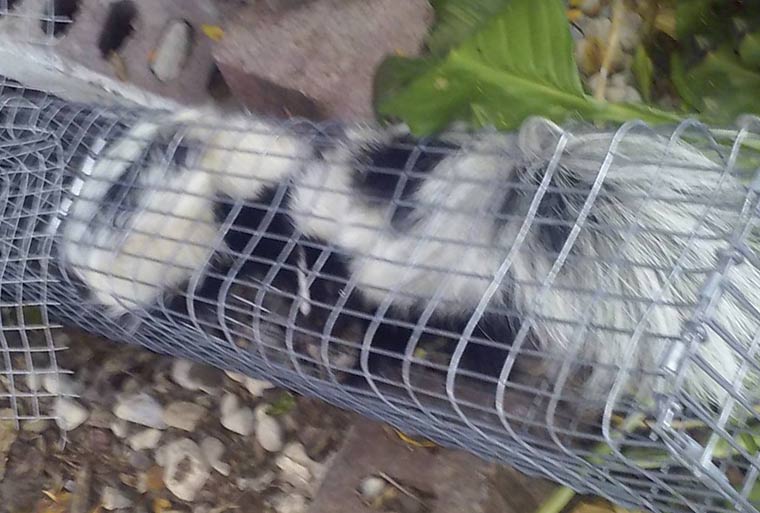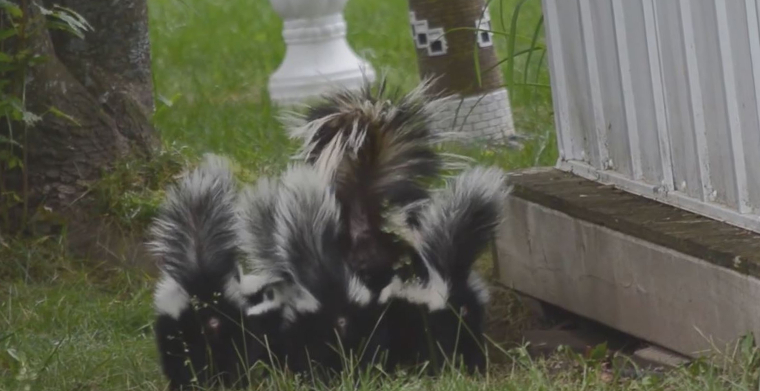-
info@aaanimalcontrol.com
Call us for help in your town
Humane Wildlife Education
Reasons why skunks spray
Need skunk removal in your hometown? We service over 500 USA locations! Click here to hire us in your town and check prices - updated for year 2020.
Skunks spray because it is their defense mechanism. It isn’t the first choice, usually called upon when all other escape missions have been exhausted. First, you will see the skunk act “big”. This will involve some noise, usually a hissing noise, and a lot of stamping of the feet. They will also flick their tail around, waving it high in the air. These are all designed to make the animal look much more intimidating than it actually is, all in a bid to scare off predators.

Certain times of the year can make a skunk more spray-active, especially when mothers are taking care of her young. If she thinks you’re about to get anywhere close to her babies, or if any other animal threatens to come close, she will first display her “scary” face, baring her teeth, hissing, and flicking that tail around, and if that doesn’t work they’ll turn around. The tail will lift, and that oh-so-offensive spray will come out.
The spray actually comes from anal glands, as if things weren’t bad enough as it was. The liquid itself is quite oily, and it smells very much like rotten egg. This is because the liquid contains compounds of sulphur, and in case you weren’t aware, that stuff really smells bad.
Skunks don’t want to spray you. They would much rather you left them alone, and if you do that - leave them alone - you will find yourself un-skunked. If you do interfere with one, however, trying to evict one from your land or home, for example, or tapping it in a cage, you are probably going to get sprayed. They can’t escape, and they think you are a predator. The skunk spray is designed to ward off bigger animals just like you! (It works quite well too, don’t you think?)
Do skunks warm before spraying?
Need skunk removal in your hometown? We service over 500 USA locations! Click here to hire us in your town and check prices- updated for year 2020.
Skunks do warn before they discharge their foul-smelling liquid, and that's because it would rather not use the liquid at all. It doesn't have a never-ending supply of the stuff, and it actually takes a good couple of weeks to replenish fully-discharged fluid stores.

Before it sprays, the skunk will make some noise, stamp its feet, and generally make a right racket. The tail will puff right up and stick up in the air, the entire body of the animal will seem to arch, and it will literally hiss and stamp its feet. It's letting you know (or whatever predatory animal it feels under attack from) that it will discharge its spray, if you ignore the loud and aggressive protests.
Healthy skunks can discharge their spray across fifteen feet, so any animal that is being warned would do well to heed it. The older the skunk, the more direct and better-aimed the spray will be, so if you're unlucky enough to come across an adult male in his prime, there's a pretty good chance you're going to get covered in the stuff.
Skunks would rather not use their spray. It is tiring for them, plus they would find themselves defenseless if they were to then come across a predator. If they wasted all of their spray reserves on an animal that wasn't worthy of it, they would have nothing to fall back on when a real, genuine threat comes across later on.
If you spot a skunk displaying these warning signs, back away, fast. They will spray at you if they feel you are a threat to them, and when you consider that you are many times the size of this small creature, you can understand their trepidation when you are anywhere near them.
For more information, you may want to click on one of these guides that I wrote:
How much does skunk removal cost? - get the lowdown on prices.
How to get rid of skunks - my main skunk removal info guide.


















